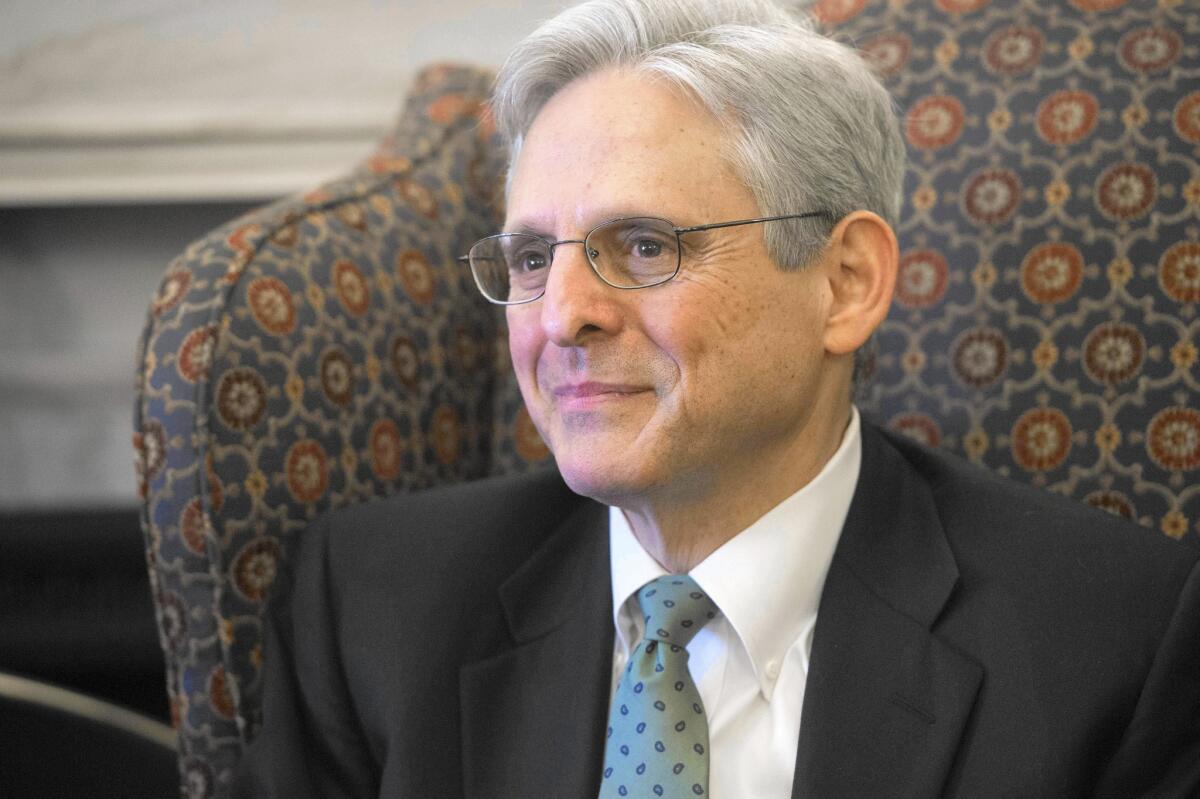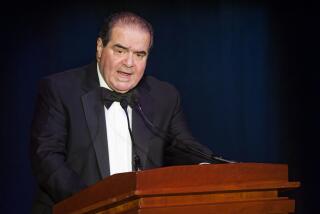Supreme Court nominee Merrick Garland has a record of restraint, not activism

Legal analysts are dissecting Merrick Garland’s past opinions as a federal judge on the U.S. Court of Appeals for the District of Columbia Circuit, looking for clues about his views and judicial philosophy.
- Share via
Reporting from WASHINGTON — Judge Merrick Garland may well be the most moderate Supreme Court nominee anyone could expect from a Democratic president, but he’s also a justice who could create the first liberal majority on the high court in more than 40 years.
That explains why President Obama, Senate Democrats and liberal activists are convinced Garland, a superbly qualified judge with a cautious, centrist record, deserves a hearing and a confirmation vote.
And it’s why Republicans and conservative activists are just as fiercely determined to block him.
One vote can make an enormous difference on a court that frequently splits 5 to 4 on important social questions. If the late Justice Antonin Scalia, a staunch conservative, is replaced by a moderate-to-liberal Justice Garland, the court would tip to the left on several key issues, like abortion, affirmative action, the death penalty, gun control, campaign spending, immigration and environmental protection.
Legal analysts are now dissecting Garland’s past opinions as a federal judge since 1997 on the U.S. Court of Appeals for the District of Columbia Circuit, looking for clues about his views and judicial philosophy. It’s been a frustrating experience, partly because the D.C. Circuit focuses more on dense regulatory questions than hot-button cultural issues.
Garland’s moderate views, preference for narrowly crafted rulings and tendency to defer to regulatory agencies and the executive branch — under both Republican and Democratic administrations — point to a reluctance to engage in the kind of judicial activism that has been condemned, at different times, by both liberals and conservatives.
In 2003, for example, Garland joined a 3-0 opinion at the D.C. Circuit that sided with the Bush administration in blocking Guantanamo Bay detainees from using civil courts to challenge their detention. That ruling was later overturned by the Supreme Court. He also deferred to the Obama administration by often siding with the Environmental Protection Agency when its rules were challenged.
“He’s worked in the government, and he tends to think the people there are doing their best and working in good faith,” said Georgetown law professor Irving Gornstein. “It doesn’t mean he will blindly follow them, but he doesn’t assume the worst and think these people are bending the law for political reasons.”
“Judicial restraint” was once the watchword of conservatives, particularly when Republicans held the White House and they didn’t want interference from the courts. Today, with a Democratic president, it is liberals calling for federal judges to uphold the administration’s actions, from immigration to environmental protection. Conservatives, meanwhile, prefer judges who will restrict the powers of the executive branch, at least as long as President Obama is in office.
The Supreme Court’s conservatives, led by Chief Justice John G. Roberts Jr., have increasingly pressed to restrain federal agencies and their regulations on issues including the environment and immigration. But Garland’s appointment could put the brakes on that move. Such a switch would be particularly significant for environmental protection.
Garland “is almost always deferential to agency interpretations of statutes,” UCLA law professor Ann Carlson wrote Wednesday, adding that his record “at least suggests he is likely to uphold the president’s signature climate initiative, the Clean Power Plan.”
Just four days before his death, Scalia joined a 5-4 order siding with coal-producing states and putting the Clean Power Plan rules on hold while a legal challenge plays out in the D.C. Circuit this year, and presumably in the Supreme Court next year.
A major environmental case decided last year highlights the difference between Justice Scalia and Judge Garland. In 1990, Congress strengthened the Clean Air Act and told environmental regulators to restrict hazardous air pollutants where it was “appropriate and necessary” to protect the public’s health. It took two decades to implement, but in 2012 the EPA under Obama adopted rules to limit emissions of mercury and other air toxins from power plants, stressing the danger to children and pregnant women.
The coal producers and several Republican-led states sued, arguing the rules were too costly. Garland joined with another Democratic appointee to uphold the regulations, over the dissent of a Republican. The Supreme Court took up an appeal, and Scalia spoke for a 5-4 majority to block the rules in June in the case of Michigan vs. EPA.
The pending battle over immigration is another major test of regulatory power. At issue is whether Obama has the authority to temporarily suspend deportation and to offer work permits to several million otherwise law-abiding immigrants who have been working and living illegally in this country. Obama’s lawyers say federal law and past Supreme Court decisions give executive officials leeway to decide who should be deported, while lawyers for Texas and 25 other Republican-led states disagree.
The Texas case will be argued in April before the eight justices. But looking forward, the ninth justice will be in a position to decide whether the next president has broad power, or a limited authority, when it comes to immigration.
On gun rights, Scalia was the foremost champion of the constitutional right to “bear arms.” His most important opinion, in District of Columbia vs. Heller, declared, for the first time, that the 2nd Amendment protected an individual’s right to have a gun at home for self-defense. It struck down an unusually strict D.C. gun control ordinance. Prior to that time, the court’s rulings had found that the amendment’s protections related to a “well-regulated militia.”
Garland played a small role in that case. He voted in 2007 to have the full D.C. appeals court reconsider the issue after one of its panels, by a 2-1 vote, struck down the D.C. ordinance as a violation of the 2nd Amendment, marking the first time a federal appeals court had declared an individual right to bear arms based on those constitutional grounds.
Garland did not explain why he wanted the full appellate court to review the case, or reveal his views about the law in question. It could reflect a skepticism on gun rights, as many conservatives are now saying as part of their campaign to block his confirmation. Or Garland could have simply been concerned about preserving the existing Supreme Court precedent, which until the Heller decision had found no individual right under the 2nd Amendment.
If the Senate holds a hearing on his nomination, the gun rights case would surely take center stage and Garland would be asked to explain his views.
One area where Garland may lean to the right is in cases involving terrorism and national security. He worked as a prosecutor and as a top Justice Department attorney at the time of the Oklahoma City bombing and the arrest of Theodore Kaczynski, the so-called Unabomber who had repeatedly sent homemade bombs through the mail.
Just as Garland respects the work of environmental regulators, friends say he also respected the teams of FBI agents who pursued the Unabomber and other domestic terrorists.
Looking ahead, the high court may also be called upon to decide matters of privacy versus security, such as the current dispute between Apple and the FBI over data encryption on smartphones. A Justice Garland may bring a special perspective to such cases.
“I think his experience with terrorism would be very important if he were on the court,” said Washington lawyer Andrew Pincus.
More to Read
Sign up for Essential California
The most important California stories and recommendations in your inbox every morning.
You may occasionally receive promotional content from the Los Angeles Times.











